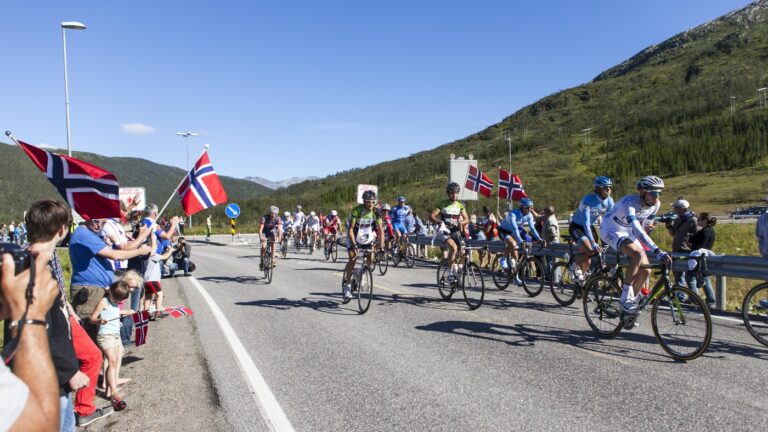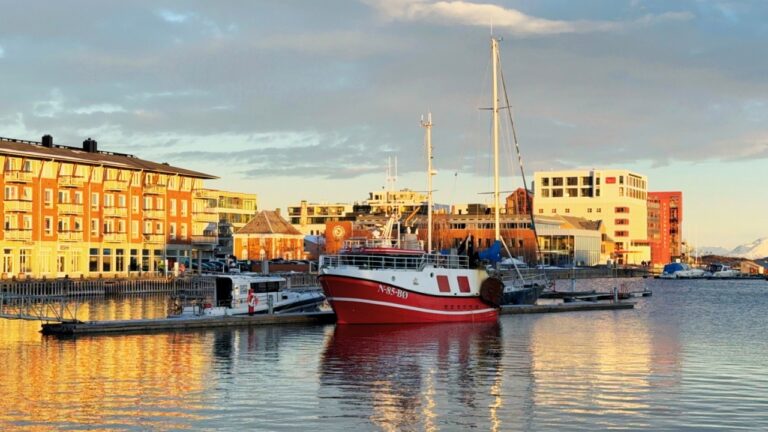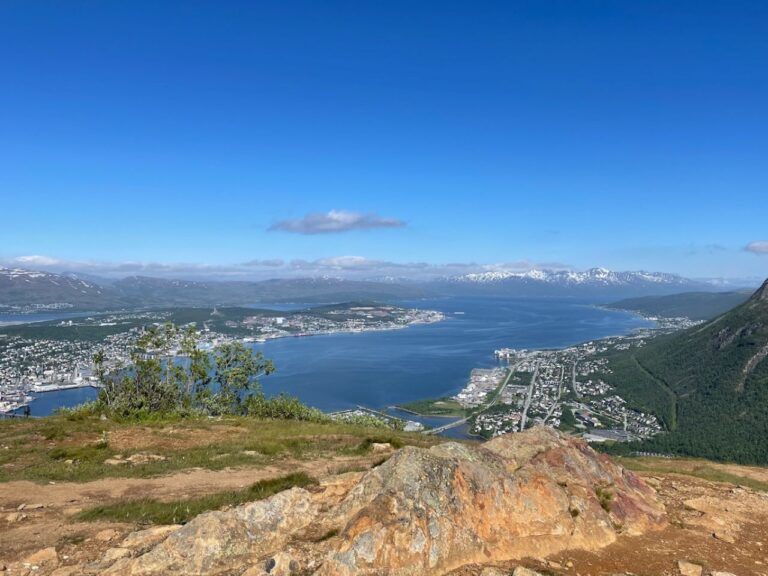World-class cycling combines with the stunning natural landscapes of northern Norway to create one of the world's most remarkable stage races. The 2025 edition takes place from 7 to 10 August.
Each summer, the far north of Norway plays host to one of professional cycling’s most spectacular events.

The Arctic Race of Norway may not be as long-established as the Tour de France or Giro d’Italia, but it has quickly built a reputation for its breathtaking routes, enthusiastic local crowds, and unique northern charm.
A Cycling Race Like No Other
Launched in 2013, the Arctic Race of Norway takes place above the Arctic Circle, offering both riders and viewers an unforgettable backdrop of dramatic mountains, coastal fjords, fishing villages, and wide-open tundra.
The race typically spans four stages over consecutive days, with routes that shift each year to showcase different parts of northern Norway, from the Lofoten Islands to the windswept plains of Finnmark.
While the unpredictable Arctic weather and rugged terrain can pose serious challenges, it’s precisely this combination of beauty and difficulty that has made the event stand out on the international cycling calendar.
An International Stage with a Local Heart
The race is organised by the same team behind the Tour de France (Amaury Sport Organisation), and it has grown steadily in prestige since its launch.
It now forms part of the UCI ProSeries, attracting a mix of top-tier WorldTour teams and ambitious pro-continental squads, many of whom use it to test young riders in a challenging but less pressurised setting.
Though it began as a niche event, the Arctic Race now draws international TV coverage and growing media interest. Yet the atmosphere on the ground remains close-knit and deeply local.
Norwegian fans line the roadside waving flags, schools organise class outings to watch the peloton pass, and entire communities get involved in the festivities.
The race is also known for its quirky prizes. In the past, stage winners have taken home local delicacies such as 500 kilograms of salmon.
Arctic Race Routes Across Northern Norway
Unlike many professional races that return to the same iconic climbs year after year, the Arctic Race of Norway is nomadic by design.
Each edition highlights a different corner of the north, sometimes weaving through the Lofoten Islands or the Vesterålen archipelago, other times venturing into the remote Sámi heartlands near the Russian and Finnish borders.
This changing route makes the race ideal for showcasing northern Norway’s geographic and cultural diversity. In some years, cyclists climb steep roads into Arctic hill towns like Hammerfest or Honningsvåg.
In others, they battle fierce coastal headwinds near Kjøllefjord or enjoy fast descents past fjords and forests near Bodø or Tromsø.

No matter the location, the race offers a valuable platform for the north. It’s a way to promote sustainable tourism, local businesses, and the broader region's identity.
Arctic Race of Norway 2025 Route
The 2025 edition focuses on Troms County, with four varied stages scheduled from 7 to 10 August. The race begins in the town of Borkenes in Kvæfjord and finishes the first day in Harstad, a coastal city that has hosted the race in previous years and offers a dramatic setting for sprinters.
Stage two begins in Tennevoll, in the municipality of Lavangen, and winds its way through mountain passes and quiet inland roads before concluding in Sørreisa.
The third stage starts on the dramatic fishing island of Husøy, located in the rugged Senja archipelago, and finishes with a challenging uphill climb at Målselv Fjellandsby, a ski resort that has featured in past editions as a signature summit finish.
The final day of the 2025 race is a high-speed circuit through the city of Tromsø. The riders will complete several laps around a hilly route within the city, including a series of short but sharp climbs that favour punchy, aggressive riders capable of explosive attacks.

With a large crowd expected to turn out in one of northern Norway’s biggest cities, the stage promises a festive atmosphere and a fitting end to the four-day event.
Notable Moments and Riders
Over the years, the Arctic Race of Norway has attracted an impressive roster of professional cyclists, ranging from young talents on the rise to seasoned veterans seeking new challenges.
Although it’s not part of the WorldTour calendar, the race’s reputation for stunning visuals, unpredictable weather, and well-organised logistics has made it a favourite among teams looking to mix competition with a unique cultural experience.
British sprinter Mark Cavendish, one of the sport’s most recognisable names, was set to appear in the 2018 edition before withdrawing due to injury. His presence alone had drawn headlines, underlining the race’s growing global pull.
Norwegian stars have often taken centre stage. Alexander Kristoff, a former Tour de France stage winner and Milan–San Remo champion, has competed several times, often using the race to connect with fans in his home country.
Fellow Norwegian Edvald Boasson Hagen, known for his versatility, has also made appearances, as has Andreas Leknessund, a promising climber who later went on to wear the pink jersey in the 2023 Giro d’Italia.
Perhaps the most memorable performance came in 2019, when Dutch phenom Mathieu van der Poel dominated the race with explosive form, winning two stages and claiming the overall victory. His aggressive, all-or-nothing riding style thrilled spectators and further boosted the race’s international profile.
And then there’s Bernhard Eisel, the Austrian rider who became an unlikely crowd favourite in 2017.
Known more for his domestique duties than podium finishes, Eisel conquered the mountains classification and was rewarded not just with the polka-dot jersey, but also a somewhat legendary prize: 500 kilograms of salmon, presented by the local fish industry.
The moment, captured by international media, became symbolic of the race’s regional pride and sense of humour.
As the race continues to grow, it’s become a proving ground for Nordic talent and a showcase for the next generation of cyclists looking to make a mark on the sport
When and Where to Watch
The Arctic Race of Norway typically takes place in mid-to-late August, when the midnight sun begins to fade but daylight still lingers long into the evening. This timing offers ideal lighting conditions for broadcasters and breathtaking views for fans following the race from afar.
In Norway, all stages are broadcast live on TV2, with replays and highlights available online. International viewers can tune in via Eurosport, the GCN+ streaming platform, or through national sports channels depending on location.
The race is also covered extensively on social media, with aerial footage and on-the-bike camera angles capturing the drama and landscape from all perspectives.
For those visiting northern Norway during the event, seeing a stage in person is a travel experience in itself. Entire towns and villages come alive when the race passes through. Streets are decorated, local schoolchildren line the roads, and impromptu community festivals spring up around the finish lines.
Unlike the major tours where you might need to jostle for a glimpse of the riders, the Arctic Race offers front-row access in a more relaxed setting.
Visitors often find themselves chatting with team staff, cheering from roadside cafés, or watching from scenic lookouts with hardly another spectator in sight.
Even if you're not a die-hard cycling fan, the chance to witness such a high-level international sporting event in such a remote and beautiful part of the world is not to be missed.

